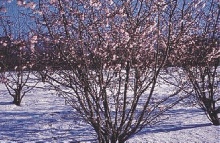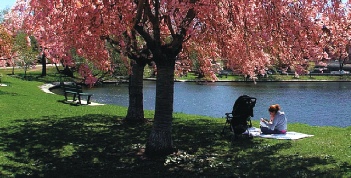In mid-April, this variety ( common name ‘Higan Cherry’ ) is often a waterfall of pink blossoms when the surrounding trees all remain bare. The common name of this tree derives from ‘Ohigan’, a Buddhist holiday celebrated in its native Japan on the autumnal and spring equinoxes. Weeping Higan cherries can be remarkably long-lived: one famous tree in Japan is over 1,000 years old. Although the trees themselves may live centuries, the flowers linger only for a short time and consequently the cherry blossoms have long symbolized not only spring, but also the transience of all things.
Plants that flower in the short dark days of mid-winter are always welcome in most gardens and Prunus x subhirtella ‘Autumnalis Rosea’, often known as the pink winter-flowering cherry, is in flower on Christmas Day unless the spell around Christmas is really cold. Buds are produced in early autumn and flowers appear during any mild spells from October until April.
The origins of many flowering cherry varieties is not really known. One story suggests this one was discovered in the late 1600’s when a Japanese emperor noticed a single specimen flowering in a courtyard in Kyoto in late autumn. More plants were propagated from the original and the tree became known as Prunus ‘Jugatsu-zakura’ translating as ‘cherry of the tenth month’ – an obvious reference to September/October time when its first flowers can open. In most years the main flowering period is April after the sporadic winter flowering but in very cold years Spring may be the only time that the tree flowers.
Obviously the tree is ‘classed’ by some as being non-native, but it should be noted … classed along with our much loved Beech, from which much of our furniture is made, Larch, Elm, London Plane, Sycamore, Walnut, Cypress, White Poplar, Holm Oak, Sweet & Horse Chestnuts an many fruit trees including Apples, Plums, and more common varieties of Cherry amongst them.
Scientists would agree that trees survive and prosper in a climate that suits them and as we experience more extremes in our weather we should be looking for varieties that can tolerate drier summers and wetter winters - and give us pleasure in the bleaker winter spells in the way that Roses, Wisteria and many other garden plants do - and that are classed as essentially ‘English Garden’ plants - So the debate should not be cut short without seriously considered thought.
(Click : for link to academic pdf on this debate]
All the trees (and their positioning) on this tree trail have been discussed with arboreal specialists






 Town Map
Town Map
















